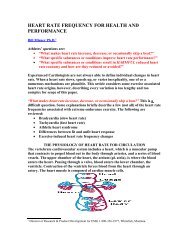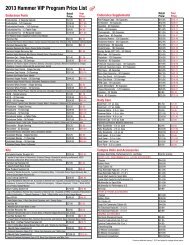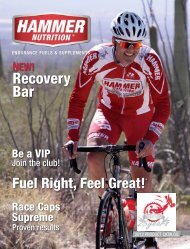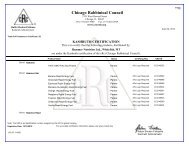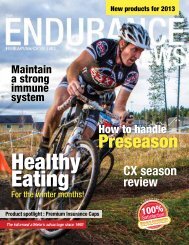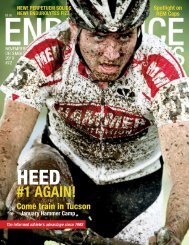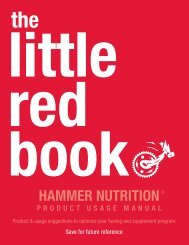Fueling For Motocross Success - Hammer Nutrition
Fueling For Motocross Success - Hammer Nutrition
Fueling For Motocross Success - Hammer Nutrition
You also want an ePaper? Increase the reach of your titles
YUMPU automatically turns print PDFs into web optimized ePapers that Google loves.
HYDRATION – What You Need to Know<br />
I won’t go into a long dissertation about how your body’s internal cooling system works but I can tell you that it<br />
involves a variety of complex mechanisms all designed to support the body during hot weather conditions, keeping it<br />
cool and protecting the vital organs. By far, the most important part of your body’s cooling system, accounting on<br />
average for about 75% of all cooling, is your ability to produce and excrete sweat.<br />
Weather conditions greatly affect sweat production and cooling effectiveness. In cool weather, you get substantial<br />
cooling from the heat that escapes directly from your skin. As the temperature increases, you gradually rely more on<br />
evaporation. On hot days, with little difference between skin surface and ambient temperatures, your skin surface<br />
provides only negligible convective cooling, and you need to sweat more to maintain a safe internal core temperature.<br />
At 95ºF or above, you lose no heat at all from your skin; you actually start to absorb it. Evaporative cooling must do all<br />
the work.<br />
Humidity is the other major factor that affects sweat. On humid days, sweat evaporates more slowly because the<br />
atmosphere is already saturated with water vapor, which drastically slows down the evaporation rate. The sweat<br />
accumulates on your skin and soaks your clothes, but you don’t get any cooling from it because it’s not evaporating.<br />
Soaking, dripping sweat may give you a psychological boost, but it has no physical efficacy to cool; sweat must<br />
evaporate to remove heat. On days when it’s both hot and humid Well, you don’t need to read about what’s going to<br />
happen when you exercise in those conditions. You do need to know that under the worst of conditions you can<br />
produce up to three liters of sweat in an hour of strenuous exercise, but your body can only absorb about one liter from<br />
fluid consumption. Yes, this will cause problems before long, and we will discuss that issue below.<br />
What Happens When the Coolant Runs Low<br />
Just like a car, your body must dissipate the excess heat generated from burning fuel. However, unlike an automobile,<br />
your body’s coolant isn’t in a sealed internal system; you use it once and then it’s gone and needs to be replaced.<br />
Unfortunately, we don’t come with built-in gauges or indicators that tell us just how much coolant we have left in our<br />
system. We can’t run a dipstick down our gullet and get a reading that says, "Add a quart." We do have some<br />
physiological signs, but they function at the “Warning-Danger!” level, too late to maintain optimal performance. <strong>For</strong><br />
instance, by the time you feel thirsty, you could have a 2% body-weight water loss, already into the impairment zone.<br />
The chart below shows what happens to human performance at each percent of weight loss. By weight loss, we mean<br />
the percentage of your body weight at the start of exercise that you have lost via sweat. If you go out for a ride at 160<br />
pounds and weigh in a few hours later at 154, you’ve lost almost 4% of your body weight.<br />
Symptoms by Percent Body Weight Water Loss:<br />
PERCENT WATER LOST --------- SYMPTOMS<br />
0% --- none, optimal performance, normal heat regulation<br />
1% --- thirst stimulated, heat regulation during exercise altered, performance declines<br />
2% --- further decrease in heat regulation, hinders performance, increased thirst<br />
3% --- more of the same (worsening performance)<br />
4% --- exercise performance cut by 20 - 30%<br />
5% --- headache, irritability, "spaced-out" feeling, fatigue<br />
6% --- weakness, severe loss of thermoregulation<br />
7% --- collapse likely unless exercise stops<br />
10% -- comatose<br />
11% -- death likely<br />
[<strong>Nutrition</strong> for Cyclists, Grandjean & Ruud, Clinics in Sports Med. Vol 13(1);235-246. Jan 1994]<br />
Over-hydration – Too Much Of A Good Thing<br />
So now you’re probably thinking, “Whoa, I’ve got to drink a lot of fluid!” Well, that’s true to some extent but while not<br />
drinking enough fluids (dehydrating) can cause some problems, drinking too much (over-hydrating) can cause just as<br />
many problems, perhaps more, some with devastating consequences.<br />
In the past several months there have been a lot of articles written about the dangers associated with over-hydration,<br />
which again, is simply drinking more fluids than your body can handle. In fact, there have been numerous athletes<br />
(runners, mostly) who drank so much fluid in hot weather that they ended up in the hospital. Some have even died (yep,<br />
died!) and it’s all due to over-hydration. With that in mind, we all know that racing motocross in the heat is more<br />
challenging than in other sports like marathon running. You don’t have the luxury of being able to race in a tank top,<br />
shorts and running shoes the way runners do. With all of your riding gear and helmet, staying hydrated and avoiding<br />
overheating is very difficult. So what do you do<br />
Well, most of the advise you’ve heard before about hydrating in the heat probably sounded something like this: “drink,<br />
drink and drink some more” or “drink even when you’re not thirsty” or “drink to replace” – <strong>For</strong>get all of this, it’s just<br />
plain wrong. Although well intentioned, this advice is inaccurate at best and can be downright dangerous at worst. At<br />
the races, over-hydration and the electrolyte depletion that goes with it causes you to feel tired, lethargic, queasy, and<br />
experience muscle cramps and many other symptoms that many have inaccurately been thought to be caused by<br />
dehydration. So needless to say, you have to be very conscientious about how much fluid you consume since too much<br />
is just as bad or worse as too little.<br />
Regardless of how hot it is, even when the heat index is well over 100, you must resist the urge to drink excessive<br />
amounts. The majority of athletes under most conditions will satisfy their hydration needs with a fluid intake in the 20-



